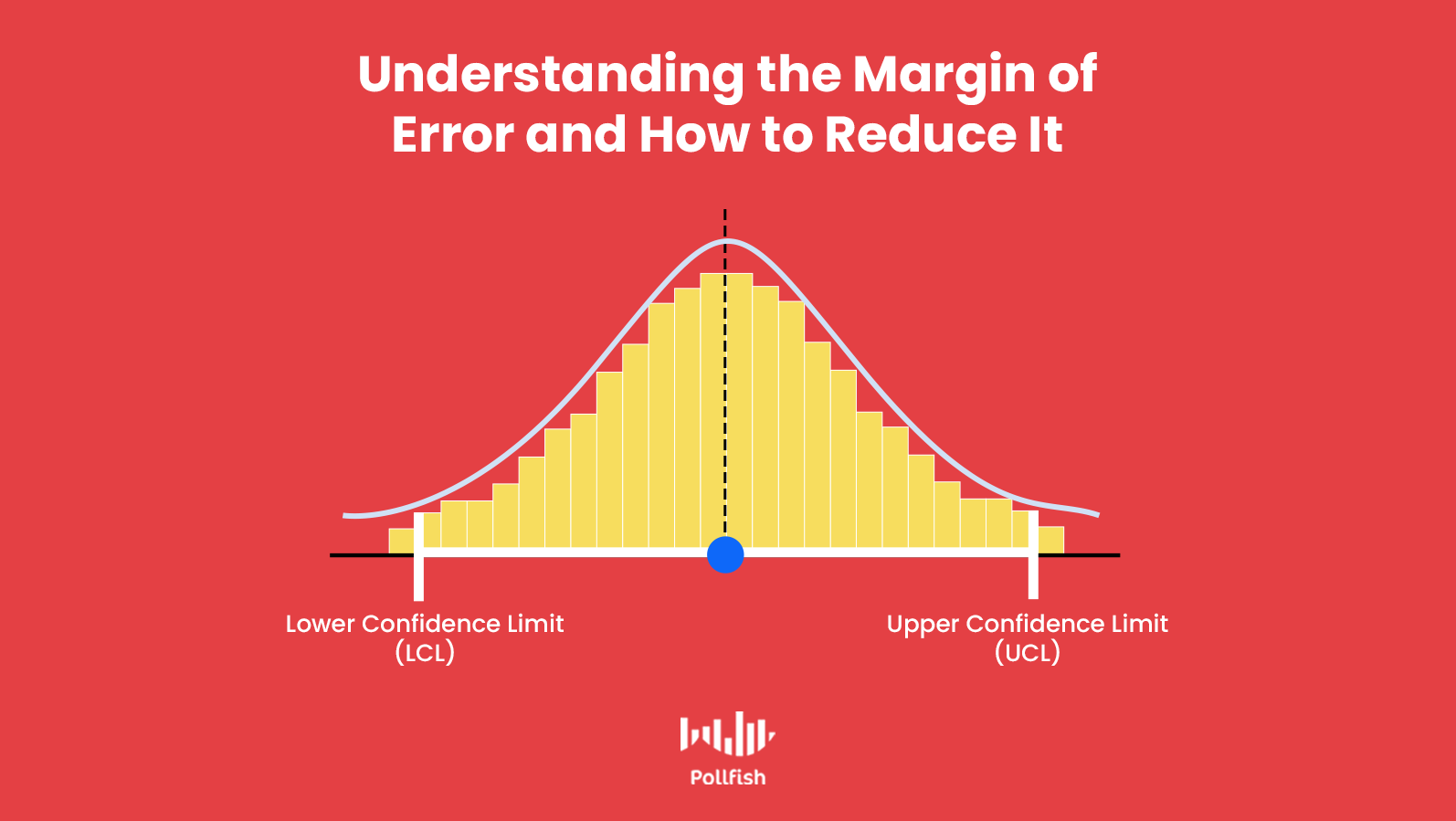What is the Margin of Error & How to Reduce it in Your Survey

You may have pondered, what is the margin of error during your survey research, as this figure is sure to come up when analyzing data and forming an accurate reading of survey results.
In survey research and statistics, this pesky error rears its ugly head omnipresently. Commonly called the margin of error, this phenomenon is also referred to as the confidence interval. Despite the latter name, it is in the best interest of researchers to keep this metric low.
This is because, no matter who you survey or how many people, it is impossible to garner responses that represent everyone in the target population of your study. This is where the core of the margin of error lies, as it shows researchers how much of a survey’s results represent the views of its target population.
This article explains what is a margin of error and how to reduce it in your survey.
Defining the Margin of Error
The margin or error — or the confidence interval — is a measurement of error in the results of a survey, specifically one that relies on the random sampling method. This metric shows researchers the degree to which they can expect survey results to reflect the views of the overall studied population.
As aforesaid, it is imperative to keep the margin of error low, as a high one points to a smaller likelihood of survey results to reflect the true views of your target population. As such, a higher margin of error renders your survey less reliable and inconclusive.
Moreover, a higher confidence interval (a misnomer as it may be) makes your survey unable to be used for statistical methods, such as in quantitative studies. It also debilitates descriptive and qualitative research.
Researchers should thus aim for a lower margin of error, as it denotes higher confidence of a survey results’ accuracy, whereas a higher one signifies the opposite.
The Utility of Studying the Margin of Error
While this statistic may be a frustrating reality in survey research, it is crucial to keep track of it. This is because survey data, necessary and enlightening as it may be, is imprecise. Why? Because survey samples represent a chunk (usually a small one) of your target population, and an even smaller one if it is in relation to your entire target market.
Since a sampling pool (survey respondents) represents a larger population, there will always be the presence of uncertainty and imprecision.
The confidence interval is useful in that it calculates this inherent imprecision to allow researchers to see how trustworthy their survey results are in representing a certain population.
Additionally, the margin of error helps researchers determine the accuracy of a value, by expressing it in a range. The margin of error supports this, since the resulting answers of a survey question get assigned a percentage for statistical survey analysis.
But since it is impossible to survey every last member of a target population, this percentage is only representative of the sampling pool. The margin of error allows this percentage to be expressed as a range to more accurately represent the answer in relation to the entire target population.
For example, if a survey’s results show that 40% of respondents sit while listening to music, this figure is incomplete. When you calculate the margin of error, on the other hand, it helps turn this figure into a more precise representation. If the margin of error turns out to be 4%, the percentage of 40% can be expressed as a range of 36-44%.
How to Calculate the Margin of Error
Calculating the margin of error requires plugging in a few variables into a formula. These include your sample size and the population standard deviation. The latter variable requires a calculation of its own.
The standard deviation is a measure of the spread of scores in a data set that pertains to a specific population. A low standard deviation entails that most of the scores are closer to the average one, while a higher standard deviation shows that the scores are more dispersed. In short, this metric is also used for the purposes of data reliability.
These variables are just a few of the key aspects of calculating the margin of error. Below is the formula in its entirety.
The Formula Explained in Steps:
- Find the population standard deviation (σ) and determine your sample size (n).
- Get the square root of your sample size.
- Divide the population standard deviation (σ) by the result of the square root calculation.
- Multiply this result by the z-score that corresponds with your desired confidence level — not to be confused with the confidence interval (which is the margin of error).
*Use the table below to find the z-score.
| z*-Values for Selected (Percentage) Confidence Levels | |
| Percentage Confidence | z*-Value |
| 80 | 1.28 |
| 90 | 1.645 |
| 95 | 1.96 |
| 98 | 2.33 |
| 99 | 2.58 |
How to Reduce the Margin of Error

As a researcher or business owner studying your target market, you are probably wondering how to reduce the margin of error. After all, a more reliable survey is going to be far more useful and one less obstacle to contend with.
Here are several best practices to input into your survey research, to reduce the confidence interval. This will help make individual answers, as well as their ensuing variables (such as mean and average), become more precise.
- Reduce the data variability. This will lessen the margin of error, as the less data variation you have, the more accurately you can estimate a parameter surrounding the population. When you reduce variability, the standard deviation also narrows, causing the margin of error to follow suit.
- Do this by changing how you gather the data. Ex: make precise measurements, make your process more orderly.
- Enlarge your sample size. Using a larger sample size allows you to make more observations. In turn, this will create a smaller interval around your sample statistic. By collecting more data, you can acquire a more exact estimate of a population parameter.
- Bear in mind that a larger sample size may require more time and resource allocation.
- Use a lower confidence level. A lower confidence level grants your margin of error with more precision, causing it to narrow. The drawback to this action is that the margin of error will then have less confidence in carrying the population parameter you need to find.
- You should thus only lower the confidence level if the benefit of more precision (a reduced margin of error) outweighs the disadvantage of a lessened confidence level.
- Example: If increasing the sample size is too costly for you, then lower the confidence level for a decreased confidence interval. Just remember, your confidence level has declined.
- Reduce the data variability. This will lessen the margin of error, as the less data variation you have, the more accurately you can estimate a parameter surrounding the population. When you reduce variability, the standard deviation also narrows, causing the margin of error to follow suit.
- Implement a one-sided confidence interval. This has a smaller margin of error than a two-sided confidence interval. This interval signifies only if a parameter is either smaller than or greater than a cut-off value.
- It doesn’t show any information about the parameter on the opposite side. As such, use this to increase an estimate’s precision of an estimate only if you fear the estimate will be greater or less than a cut-off value, i.e., not both.
Using the Correct Survey Platform
Can using a strong online survey tool help decrease the margin of error? The answer is rather complicated. On one hand, a strong survey tool will help you avoid inaccuracies (think gibberish answers, straightlining, etc.) and illogical questions. It can also help ambiguity with open-ended questions.
These aspects are certainly crucial in helping eliminate ambiguity. But there are things that affect the margin of error that a survey simply has no control over.
For example, the population size and confidence level are factors outside of a survey and its hosting platform.
With this in mind, you should understand that the margin of error cannot be fully diminished. It is impossible to perfectly align with the population you’re surveying. Especially when certain respondents have a tendency to change their minds. However, you can still determine how close you are to precisely reflecting their views by determining the margin of error yourself, or by calculating it with a designated tool (such as the one hyperlinked at the very beginning of this article).
What’s most important about an online survey platform is that it can deliver peace of mind on so many aspects that go into survey research, minimizing the labor that you need to exert into your studies and making the process much smoother and easier when it comes to reaching results (and analyzing them).
Pollfish Marketing Team
Ready to Try Pollfish?
Create your survey with AI, target high-quality respondents starting at $0.95 per complete, and start getting results in just minutes in real-time. From running a simple product concept survey to managing a constant stream of trackers for dozens of clients in dozens of countries, we’ve got you.

